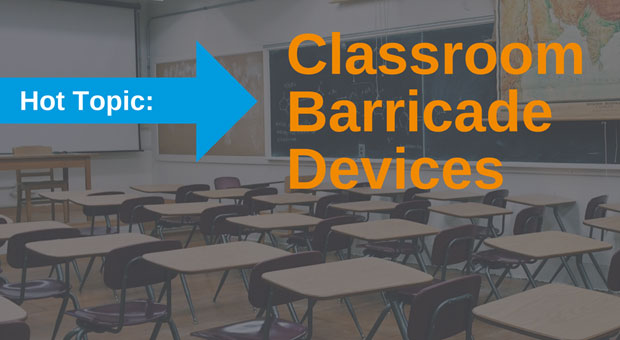A hot topic lately has been the discussion about the various methods to keep faculty and students safe in an intruder situation. In the past few years barricade devices have grown in popularity as an appealing option to keep intruders out of a classroom. A teacher could slide a barricade device under the door, or put it over the hydraulic door closer arm at the top of the door as a way to block the door from entry.
Are Barricade Devices Safe?
While barricade devices may appear to be a safe, appealing option, they are prohibited due to violating Fire and Life Safety Codes, which call for one operation to operate a door on the egress side. Meaning, there should only be one action needed to exit a room, ie. turning a doorknob. Barricade devices provide multiple safety concerns due to their physical attributes or intended installation method. If an individual is small in stature such as children, in a wheelchair, visually impaired, or injured, it is likely they will be unable to assemble/remove a heavy barricade device or one that is out of reach because it is at the top of the door.
With keeping people out of a barricaded room also comes the issue of keeping people in a barricaded classroom. If a barricade device is in use and there was a fire or a panic situation where people are rushing towards the door, it would take more effort to locate and remove the barricade before being able to exit the room safely. Also, a person could take the barricade device and lock someone in a room to harm them, while those trying to help would be locked out. Another instance would be in the case of first responders who are trying to get inside the classroom. If the occupants of the room were rendered incapable of removing the barricade, first responders would not be able to gain quick access in order to help.
Safe Solutions and Alternatives
Fortunately, there are numerous code friendly solutions that provide safety for faculty and students, while meeting Fire and Life Safety regulations. In past years, education facilities have often had doors which would only lock by using a key on the outside. The individual with the key would have to open the door and step out into the hallway to lock the door, and as you can imagine, this is not ideal when there is an intruder lurking about. At LaForce, we offer the Classroom Security Lock as a solution. This lock utilizes a key from inside the room to lock the outside of the door, with the lock always being free from the inside. Furthermore, the lock is controlled by a key from an authorized person, thus eliminating the ability for anyone in the room to initiate a barricade for the purpose of harming room occupants.
As resources have grown in the industry the use of electronic locks has become more popular. Keycards or key fobs allow school faculty to quickly and easily lock/unlock the outside of a door, from either the inside or outside of the classroom. These cards or fobs would be kept with the faculty member at all times. There is also the option of having a master lockdown system, which would lock an entire building or department with a push of a button from a command post or secured location. All of these options could lock a specific door, multiple doors within a department, or the entire school within seconds.
Furthermore, what if a school wants to have all classroom doors in a locked state each time class is in session? Electronic locks could be programmed to unlock during the passing periods and relock when class time begins. The only way to gain access to the room during class would be by an authorized credential (keycard or fob) or if someone in the room opened the door. As long as the door is closed after these actions, the door remains locked. What is comforting about this option is that the doors would already be in a locked state in the event of an intrusion.
These solutions, like the mechanical hardware solution, would never be able to lock the inside of the door, only on the outside. Therefore meeting the Fire and Life Safety codes that require the inside to always be free, even when the outside is locked.
At LaForce, we can help to provide different options to keep your educational facilities up to code while having the best security system to keep faculty and students safe.
We invite you to learn more about LaForce’s work with safety in educational facilities by viewing the Ripon College Featured Project in which LaForce installed a new security management system. You can also contact our Security Integration team today to schedule a free consultation and learn more about keeping your school safe.
Update: In September 2018, Lori Greene of iDigHardware shared a guide to safer schools from Popular Mechanics. The guide discusses how to make buildings more secure – the right way, that is in compliance with life safety codes.
Special thanks to Kristi Dietz, AHC, LaForce Engineering Training Manager, for providing technical expertise for this blog.



Follow Us